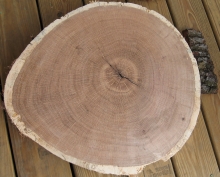You are here
Study: Climate Legacy in Eastern Old-Growth Forests

A new study released this week in Ecological Monographs, led by Lamont-Doherty Earth Observatory ecologist Neil Pederson in collaboration with Harvard Forest ecologist Dave Orwig and others, highlights the fundamental shifts and lasting legacy left by climate events like drought, even in the rainy eastern U.S.
An analysis of tree rings spanning more than 300,000 square miles and 400 years of history reveal a massive burst of new trees just before the American Revolution -- the result of widespread tree death from repeated drought leading up to the 1770s, followed by an intense drought from 1772 to 1775, and clinched by a late spring frost in 1774.
The "baby boom" of new trees that followed shaped the old-growth forests that still stand in the Southeast today.
Pederson, who will join the Harvard Forest staff as a senior ecologist in fall 2014, notes that as climate warms, increasing drought conditions and earlier springs like that of 1774 could easily expose eastern forests to the kinds of conditions that changed them so abruptly in the 17th and 18th centuries.
Support for this study came from the US Department of Energy's Global Change Education Program, the Kentucky State Nature Preserve Commission's Small Grant Program, Kentucky Academy of Sciences, Eastern Kentucky University's University Research Committee, and the Kentucky Natural History Society.
- Read the Harvard Gazette story and browse photos.
- Read the full pre-print in Ecological Monographs.

